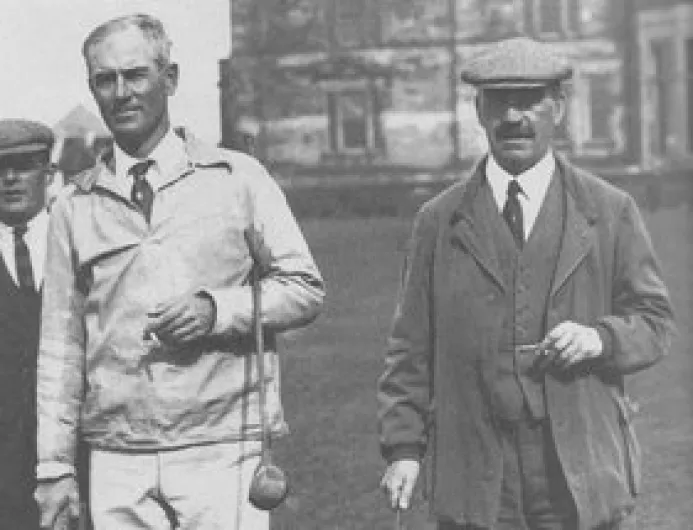Behr, 2-time Amateur Champ And Architect, Helped Shape Augusta

Pictured: Max Behr, left, and Alister MacKenzie
The winner of two New Jersey State Golf Association Amateur championships is the subject of a six-page feature article in the March 18, 2013 issue of GolfWorld magazine.
Max Behr, hardly is the first name that comes to mind when New Jerseyans consider their two-time Amateur champions, but Behr’s legacy concerns golf-course design and work as s pioneer golf magazine editor.
Behr, of Morris County GC, won the State Amateur in 1909 and 1910, the second time defeating the legendary Jerome Travers of Montclair (who won four U.S. Amateurs and a U.S. Open). He had lost to Travers in the State Amateur finals in 1908 and ’07 and in the U.S. Amateur final in 1908.
In 1914, he was the founder and editor of Golf Illustrated. Yet it was his move to California four years later, after his wife died unexpectedly, that saw his rebirth as a golf-course architect. By the time his life’s work was done, Behr was credited with inventing a handicap system and his own religion.
Behr, who graduated Lawrenceville School and Yale University, played as a member at Morris County, Somerset Hills and Baltusrol. His father and grandfather were founding members of the first golf club in America, historic St. Andrews Golf Club in Yonkers, N.Y.. It was while playing on Yale’s golf team that Behr learned the finer points of golf and golf courses from his coach, Robert Pryde, who was a golf course designer in his own right
The current article on Behr, by author Geoff Shackelford, credits him with having a positive effect on Bobby Jones’s future design – with Aliister McKenzie – of Augusta.
Shackelford writes: “(At Augusta) Many of these seemingly random bumps, dips, mounds and the original course’s extraordinary width have long been established as part of an homage to the Old Course at St. Andrews by architects Alister MacKenzie and Bobby Jones. Yet the audacity to build such uncharacteristic links must have been encouraged by something Jones and McKenzie could draw upon for reference.
“….The answer is easy if you take it logically. …. Look no further than Lakeside GC in North Hollywood, Calif., filming location for most of Jones’ 1931 “How I Play Golf” instructional series and an ahead-of its-time design by underappreciated course architect Max Behr.”
Behr had developed Lakeside from a flat orchard into an undulating natural-appearing links course.
MacKenzie praised Behr’s work at the course: “Lakeside had none of the natural advantages of the Monterey course, the Olympic at San Francisco or even many of the other courses in Los Angeles district, but it has been so admirably designed and constructed that it compares favorably with any inland course. In a word, Lakeside is one of the world’s greatest golf courses.”
In Southern California, Behr is best known for a string of great golf courses which he designed over a five-year span, beginning with Hacienda Golf Club in 1922 and ending with Rancho Santa Fe GC in 1927.
The Southern California Golf Association noted his local contributions in its history archive:
In his somewhat radical design philosophy, Behr didn't believe in rough on courses, preferring instead "to use natural terrain and bunkers to defend [his] greens from every conceivable angle."
That philosophy first appeared at Hacienda GC, Montebello GC, Rancho Park GC and Montecito GC, all of which he designed in 1922 and was fully developed in 1924 when he designed Lakeside GC and Oakmont CC. Lakeside was a landmark in that it used bent-grass greens, one of the first courses in Southern California to do so.
Behr's work was obviously popular. He remodeled Victoria Club in 1923, Brentwood CC two years later, and in 1926 was a consultant on the remodeling of The Olympic Club's Lake Course in San Francisco.
In 1927, Behr was paid $9,000 to design Rancho Santa Fe Golf Club in the exclusive enclave north of San Diego. That was a princely figure; Alister MacKenzie had earned only $8,000 to design Cypress Point Club on the Monterey Peninsula.
Rancho Sante Fe, Behr’s final course design, opened in 1929, the year of the Great depression which put a halt to golf course construction at the time.
Of Rancho Santa Fe, Behr himself wrote, “a new principle of golf course design has been put into effect at Rancho Santa Fe which permits the average golfer, even the beginner, to enjoy the round without constantly being in trouble and yet at the same time offers the expert a serious and exciting test of golf. Not a single hazard has been constructed with the idea of penalizing errors of skill. On the contrary, the hazards are located with the sole object of defending the hole.”
Golf nobility such Walter Hagen and Babe Zaharias to Annika Sorenstam and Tiger Woods, have played Rancho Santa Fe. Today it is the home address and home course of Phil Mickelson.
Behr continued to write about course design and construction and the rules of golf and to advocate acceptance of a standard golf ball that floats in water.
Late in life Max Behr became outspoken in his political views, and he even devised a religion based on numbers. In 1955, at age of 89, he died, leaving behind a legacy of great golf courses in California and elsewhere, even in places such as Augusta, Ga.
--Mike Moretti
